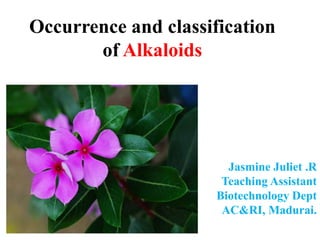
Occurrence and classification of alkaloids
- 1. Occurrence and classification of Alkaloids Jasmine Juliet .R Teaching Assistant Biotechnology Dept AC&RI, Madurai.
- 3. The first individual alkaloid, morphine, was isolated in 1804 from the opium poppy (Papaver somniferum).
- 4. Alkaloid - Definition • Alkaloid is defined as organic products of natural or synthetic origin which are basic in nature, and contain one or more nitrogen atoms, normally heterocyclic nature, and possess specific physiological actions on human or animal body, when used in small quantities.
- 6. Alkaloids - History • “Alkaloids" was introduced in 1819 by the German chemist Carl Friedrich Wilhelm Meißner, ('ashes of plants'). • The term came into wide use only after the publication, by Oscar Jacobsen in the 1880s. • In 1804, the German chemist Friedrich Sertürner isolated from opium, which he called "morphium“ (Greek god of dreams). • The term "morphine", used by the French physicist Joseph Louis Gay. • The first complete synthesis of an alkaloid was achieved in 1886 by the German chemist Albert Ladenburg (coniine ).
- 7. Occurrence of Alkaloids • Alkaloids are produced by a large variety of organisms including: bacteria, fungi, plants, and animals.
- 8. Occurrence of Alkaloids • Distribution in nature: • Alkaloids are found: in certain types of fungi, such as psilocybin, in animals, such as bufotenin in the skin of some toads and a number of insects, markedly ants. Many marine organisms also contain alkaloids. • Some amines, such as adrenaline and serotonin, which play an important role in higher animals, are similar to alkaloids in their structure and biosynthesis and are sometimes called alkaloids.
- 9. Occurrence of Alkaloids • Distribution in nature: • Alkaloids are generated by various living organisms, especially by higher plants – about 10 to 25% of those contain alkaloids. • Depending on the type of plants, the maximum concentration is observed in the leaves (black henbane), fruits or seeds (Strychnine tree), root (Rauvolfia serpentina) or bark (cinchona). • Furthermore, different tissues of the same plants may contain different alkaloids.
- 10. Distribution and Occurrence o Rare in lower plants. o Dicots are more rich in alkaloids than Monocots. o Families rich in Alkaloids: Apocyanaceae, Rubiaceae, Solanaceae, and Papavercea. o Families free from Alkaloids: Rosaceae, Labiatae.
- 11. Distribution and Occurrence All parts e.g. Datura Barks e.g. Cinchona Seeds e.g. Nux vomica Roots e.g. Aconite Fruits e.g. Black pepper Leaves e.g. Tobacco Latex e.g. Opium
- 12. Strychnine tree. Its seeds are rich in strychnine and brucine.
- 13. Classification of Alkaloids I. Alkaloids are classified based on similarity of the carbon skeleton: Indole, isoquinoline, and pyridine
- 14. Classification of Alkaloids I. Alkaloids are often classified on the basis of their chemical structure. • Eg: Alkaloids that contain a ring system indole are known as indole alkaloids. • On this basis, the principal classes of alkaloids are: pyrrolidines, pyridines, tropanes, pyrrolizidines, isoquinolines, indoles, quinolines, terpenoids and steroids.
- 15. Classification of Alkaloids I. Chemical classification: • The alkaloids are categorised into three divisions. a. True alkaloids: These have heterocyclic ring with nitrogen and derived from amino acids. b. Proto alkaloids: These does not have heterocyclic ring with nitrogen and derive from amino acids, e.g. colchicine. c. Pseudo alkaloids: These have heterocyclic ring with nitrogen and derived from terpenoids or purines but not derived from amino acids.
- 18. Classification of Alkaloids II. Taxonomical classification: • This classification is based on the distribution of alkaloids in various plant families: solanaceous alkaloids papilionaceous alkaloids. • Some times they are grouped as per the name of grouped genus in which they occur, e.g. ephedra, cinchona, etc.
- 19. Classification of Alkaloids II. Alternatively, alkaloids can be classified according to the biological system in which they occur. • For example, the opium alkaloids occur in the opium poppy (Papaver somniferum).
- 21. Classification of Alkaloids III. Further Alkaloids are classified based on biochemical precursor: ornithine, lysine, tyrosine, tryptophan, etc.,
- 25. Classification of Alkaloids IV. The medicinal properties of alkaloids are quite diverse. • Morphine is a powerful narcotic used for the relief of pain. • Codeine, the methyl ether derivative of morphine found in the opium poppy, is an excellent analgesic that is relatively nonaddictive. • Certain alkaloids act as cardiac or respiratory stimulants. • Quinidine, which is obtained from plants of the genus Cinchona, is used to treat arrhythmias, or irregular rhythms of the heartbeat.